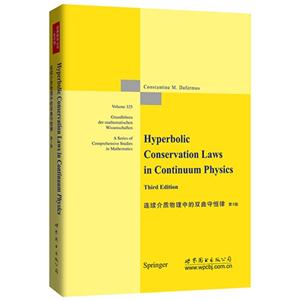Ⅰ Balance Laws 1.1 Formulation of the Balance Law 1.2 Reduction to Field Equations 1.3 Change of Coordinates and a Trace Theorem 1.4 Systems of Balance Laws 1.5 Companion Balance Laws 1.6 Weak and Shock Fronts 1.7 Survey of the Theory of BV Functions 1.8 BV Solutions of Systems of Balance Laws 1.9 Rapid Oscillations and the Stabilizing Effect of Companion Balance Laws 1.10 NotesⅡ Introduction to Continuum Physics 2.1 Bodies and Motions 2.2 Balance Laws in Continuum Physics 2.3 The Balance Laws of Continuum Thermomechanics 2.4 Material Frame Indifference 2.5 Thermoelasticity 2.6 Thermoviscoelasticity 2.7 Incompressibility 2.8 Relaxation 2.9 NotesⅢ Hyperbolic Systems of Balance Laws 3.1 Hyperbolicity 3.2 Entropy-Entropy Flux Pairs 3.3 Examples of Hyperbolic Systems of Balance Laws 3.4 NotesⅣ The Cauchy Problem 4.1 The Cauchy Problem: Classical Solutions 4.2 Breakdown of Classical Solutions 4.3 The Cauchy Problem: Weak Solutions 4.4 Nonuniqueness of Weak Solutions 4.5 Entropy Admissibility Condition 4.6 The Vanishing Viscosity Approach 4.7 Initial-Boundary Value Problems 4.8 NotesⅤ Entropy and the Stability of Classical Solutions 5.1 Convex Entropy and the Existence of Classical Solutions 5.2 The Role of Damping and Relaxation 5.3 Convex Entropy and the Stability of Classical Solutions 5.4 Involutions 5.5 Contingent Entropies and Polyconvexity 5.6 Initial-Boundary Value Problems 5.7 NotesⅥ The L1 Theory for Scalar Conservation Laws 6.1 The Cauchy Problem: Perseverance and Demise of Classical Solutions 6.2 Admissible Weak Solutions and their Stability Properties 6.3 The Method of Vanishing Viscosity 6.4 Solutions as Trajectories of a Contraction Semigroup 6.5 The Layering Method 6.6 Relaxation 6.7 A Kinetic Formulation 6.8 Fine Structure of L1 Solutions 6.9 Initial-Boundary Value Problems 6.10 The Lt Theory for Systems of Conservation Laws 6.11 NotesⅦ Hyperbolic Systems of Balance Laws in One-Space Dimension 7.1 Balance Laws in One-Space Dimension 7.2 Hyperbolicity and Strict Hyperbolicity 7.3 Riemann Invariants 7.4 Entropy-Entropy Flux Pairs 7.5 Genuine Nonlinearity and Linear Degeneracy 7.6 Simple Waves 7.7 Explosion of Weak Fronts 7.8 Existence and Breakdown of Classical Solutions 7.9 Weak Solutions 7.10 NotesⅧ Admissible Shocks 8.1 Strong Shocks, Weak Shocks, and Shocks of Moderate Strength 8.2 The Hugoniot Locus 8.3 The Lax Shock Admissibility Criterion; Compressive, Overcompressive and Undercompressive Shocks.
8.4 The Liu Shock Admissibility Criterion 8.5 The Entropy Shock Admissibility Criterion 8.6 Viscous Shock Profiles 8.7 Nonconservative Shocks 8.8 NotesⅨ Admissible Wave Fans and the Riemann Problem 9.1 Self-Similar Solutions and the Riemann Problem 9.2 Wave Fan Admissibility Criteria 9.3 Solution of the Riemann Problem via Wave Curves 9.4 Systems with Genuinely Nonlinear or Linearly Degenerate Characteristic Families 9.5 General Strictly Hyperbolic Systems 9.6 Failure of Existence or Uniqueness; Delta Shocks and Transitional Waves 9.7 The Entropy Rate Admissibility Criterion 9.8 Viscous Wave Fans 9.9 Interaction of Wave Fans 9.10 Breakdown of Weak Solutions 9.11 NotesⅩ Generalized Characteristics 10.1 BV Solutions 10.2 Generalized Characteristics 10.3 Extremal Backward Characteristics 10.4 NotesⅪ Genuinely Nonlinear Scalar Conservation Laws 11.1 Admissible BV Solutions and Generalized Characteristics 11.2 The Spreading of Rarefaction Waves 11.3 Regularity of Solutions 11.4 Divides, Invariants and the Lax Formula 11.5 Decay of Solutions Induced by Entropy Dissipation 11.6 Spreading of Characteristics and Development of N-Waves 11.7 Confinement of Characteristics and Formation of Saw-toothed Profiles 11.8 Comparison Theorems and L1 Stability 11.9 Genuinely Nonlinear Scalar Balance Laws 11.10 Balance Laws with Linear Excitation 11.11 An Inhomogeneous Conservation Law 11.12 NotesXII Genuinely Nonlinear Systems of Two Conservation Laws 12.1 Notation and Assumptions 12.2 Entropy-Entropy Flux Pairs and the Hodograph Transformation 12.3 Local Structure of Solutions 12.4 Propagation of Riemann Invariants Along Extremal Backward Characteristics 12.5 Boundson Solutions 12.6 Spreading of Rarefaction Waves 12.7 Regularity of Solutions 12.8 Initial Datain LI 12.9 Initial Data with Compact Support 12.10 Periodic Solutions 12.11 NotesXIII The Random Choice Method 13.1 The Construction Scheme 13.2 Compactness and Consistency 13.3 Wave Interactions, Approximate Conservation Laws and Approximate Characteristics in Genuinely Nonlinear Systems 13.4 The Glimm Functional for Genuinely Nonlinear Systems 13.5 Bounds on the Total Variation for Genuinely Nonlinear Systems 13.6 Bounds on the Supremum for Genuinely Nonlinear Systems ...
13.7 General Systems 13.8 Wave Tracing 13.9 lnhomogeneous Systems of Balance Laws 13.10 NotesXIV The Front Tracking Method and Standard Riemann Semigroups..
14.1 Front Tracking for Scalar Conservation Laws 14.2 Front Tracking for Genuinely Nonlinear Systems of Conservation Laws 14.3 The Global Wave Pattern 14.4 Approximate Solutions 14.5 Bounds on the Total Variation 14.6 Bounds on the Combined Strength of Pseudoshocks 14.7 Compactness and Consistency 14.8 Continuous Dependence on Initial Data 14.9 The Standard Riemann Semigroup 14.10 Uniqueness of Solutions 14.11 Continuous Glimm Functionals, Spreading of Rarefaction Waves, and Structure of Solutions 14.12 Stability of Strong Waves 14.13 NotesXV Construction of BV Solutions by the Vanishing Viscosity Method 15.1 The Main Result 15.2 Road Map to the Proof of Theorem 15.1.1 15.3 The Effects of Diffusion 15.4 Decomposition into Viscous Traveling Waves 15.5 Transversal Wave Interactions 15.6 Interaction of Waves of the Same Family 15.7 Energy Estimates 15.8 Stability Estimates 15.9 NotesXVI Compensated Compactness 16.1 The Young Measure 16.2 Compensated Compactness and the div-curl Lemma 16.3 Measure-Valued Solutions for Systems of Conservation Laws and Compensated Compactness 16.4 Scalar Conservation Laws 16.5 A Relaxation Scheme for Scalar Conservation Laws 16.6 Genuinely Nonlinear Systems of Two Conservation Laws ...
16.7 The System of Isentropic Elasticity 16.8 The System of Isentropic Gas Dynamics 16.9 NotesXVII Conservation Laws in Two Space Dimensions 17.1 Self-Similar Solutions for Multidimensional Scalar Conservation Laws 17.2 Steady Planar Isentropic Gas Flow 17.3 Self-Similar Planar Irrotational Isentropic Gas Flow 17.4 Supersonic Isentropic Gas Flow Past a Ramp of Gentle Slope 17.5 Regular Shock Reflection on a Wall 17.6 Shock Collision with a Steep Ramp 17.7 NotesBibliographyAuthor IndexSubject Index


















